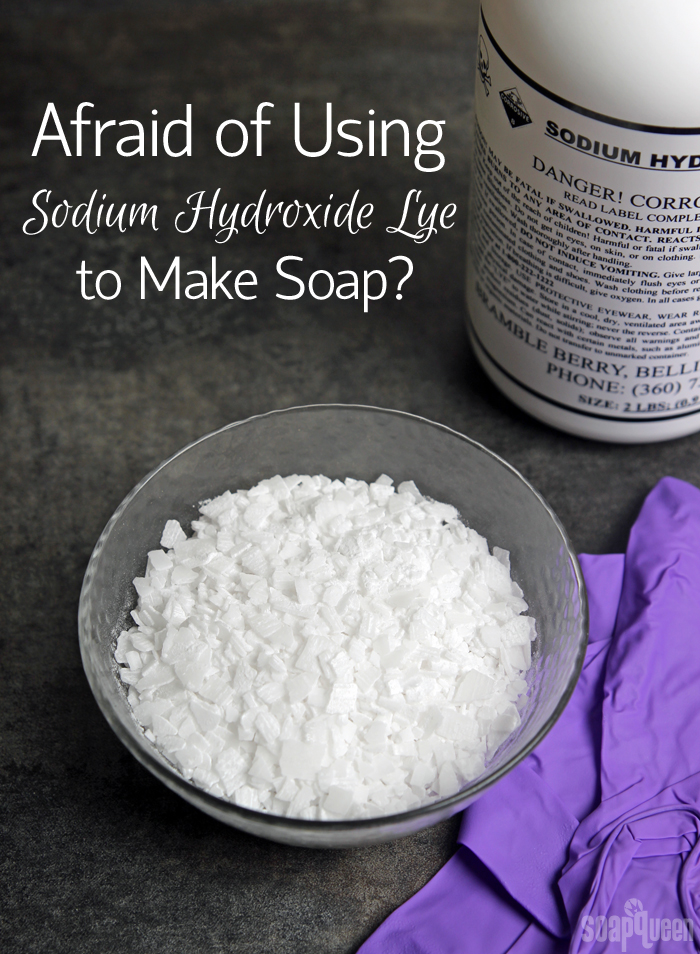
When I started making soap at 16 years old, I rendered my own fat and started my foray into all-things-soap with cold process soap. That was messy. Ingredients were hard to come by. And there was zero instruction out there. My first five batches failed. Then, I made melt and pour. It wasn’t the popular craft it is today. It was hard to find the bases, and handmade soap wasn’t the rage at craft fairs. But after just one melt and pour project, I became totally obsessed with the process. So much so that two years later, I started selling melt and pour at local markets part time.
Around that time, I started re-engaging with cold process soap. If you’re a soaper who transitioned from melt and pour to cold process, you know how intimidating it can be. Melt and pour is rather predicable, and you know within a few hours if it turned out or not. The main source of anxiety when leaping into cold process soap is the introduction of lye, aka: sodium hydroxide. It even has a bit of a scary name, doesn’t it?
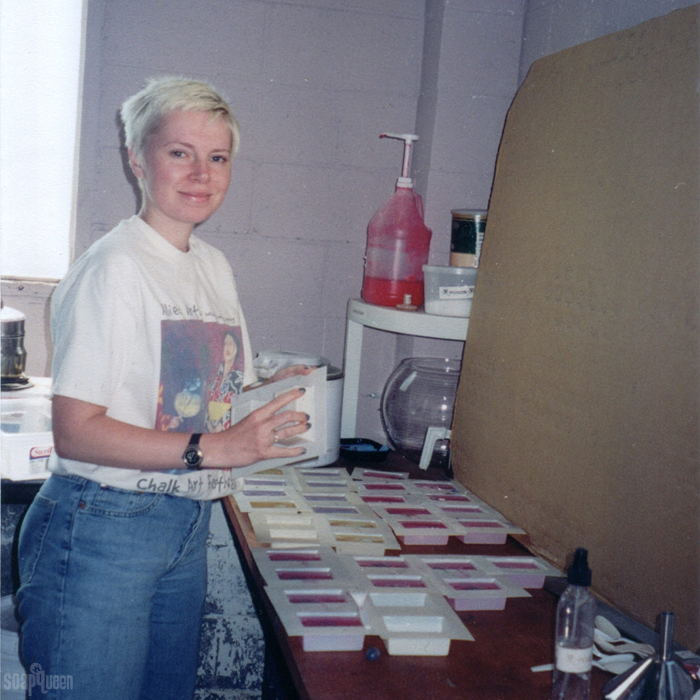 I made melt and pour for several years before trying cold process soap.
I made melt and pour for several years before trying cold process soap.
If the fear of lye is holding you back from transitioning to cold process soap…I completely understand. Lye is a caustic chemical that can cause bodily harm and it should be handled with utmost care. But, lye is perfectly safe when handled correctly. This is true for most things in life, from driving a car to mundane tasks like turning on a gas stove. With proper safety precautions, working with lye is safe and easy. For full details on lye safety, check out the Lye Safety Guide.
In fact, you’ve probably handled lye before. Have you used Drano or other drain cleaner? Check out the ingredients. Sodium hydroxide will be there, front and center. Drain cleaners usually contain other chemicals that make them unsuitable to use in cold process soap. But, they use the same active ingredient: sodium hydroxide lye. Kinda neat, huh? =)
Let’s talk about what lye is not. Lye is not the chemical in the movie Fight Club. For many, the scene in Fight Club when lye powder is dowsed on Edward Norton’s hand is their only knowledge of sodium hydroxide. It’s a gory scene that has definitely left its mark on the idea of soapmaking. Many times when I tell people I sell soaping supplies they say, “soapmaking…like in Fight Club!?” Lye on the skin can be painful, but it’s not an immediate flesh-eating experience (sorry for the visual!) like shown in the movie.
So, you might be wondering…what does lye actually feel like on the skin? If you touch a lye flake with bare hands, you probably won’t feel much for a while. Then, it will start to itch and sting a bit. If you get lye solution (lye mixed with water) on your skin, you’ll notice a burning/itchy sensation. If the lye solution is freshly made and quite hot, it will burn much more dramatically.
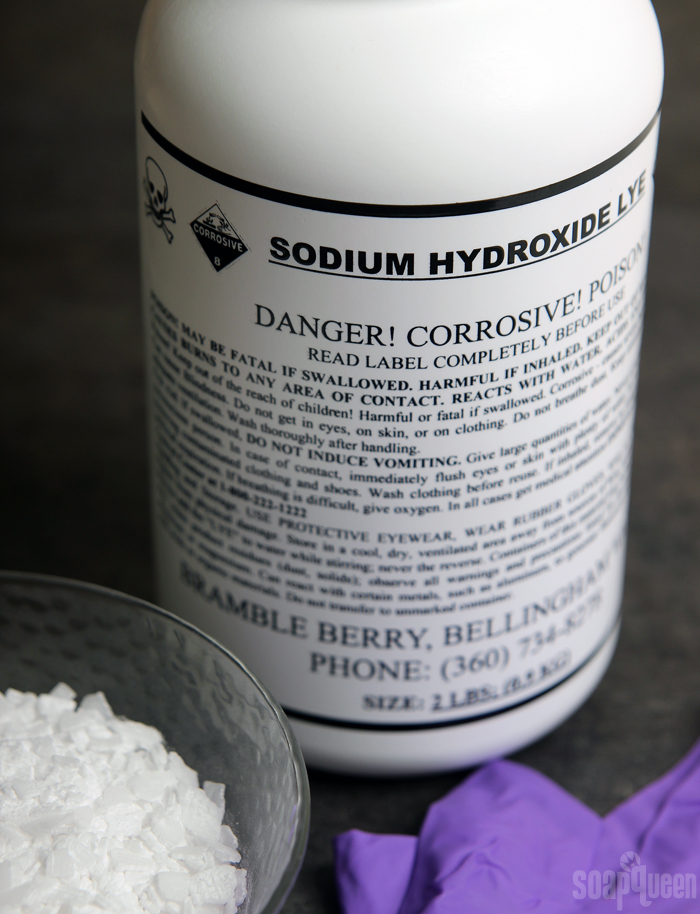 One look at a container of sodium hydroxide lye, and you know it’s dangerous. Lye safety needs to be taken seriously, but it’s not quite the chemical depicted in Fight Club.
One look at a container of sodium hydroxide lye, and you know it’s dangerous. Lye safety needs to be taken seriously, but it’s not quite the chemical depicted in Fight Club.
That being said, I’m sure plenty of soapers will tell you they didn’t notice cooled lye solution on their skin until minutes later. After that amount of time on the skin, the lye begins to irritate the skin more seriously, and you’ll notice. The burning and itching feeling is more intense (but nothing like Fight Club!) Immediately remove any contaminated clothing and rinse the skin with water for at least 15 minutes. If it comes in contact with eyes, flush immediately with water for at least 15 minutes and get medical attention. If inhaled, move to fresh air.
Now, I know all that sounds scary. But, that’s why you always, always suit up for safety. This includes:
- Wearing long sleeves, long pants and closed toed shoes.
- Wearing protective gloves.
- Wearing eye goggles.
Completely covering your body, arms, legs, hands and eyes drastically reduces any chance of your skin coming in contact with lye.
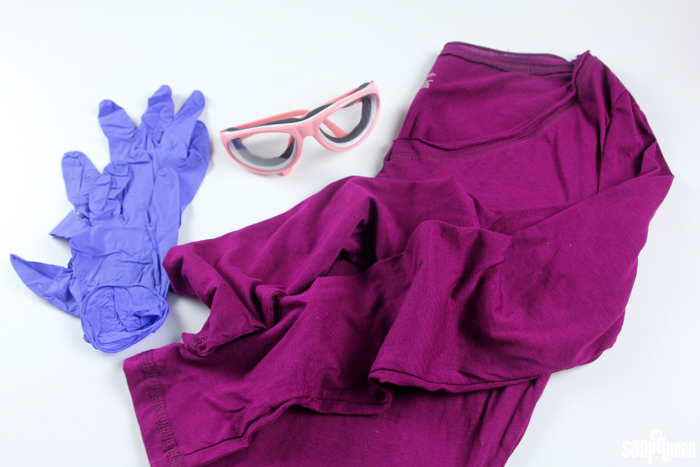 Wearing proper safety attire is essential when working with lye.
Wearing proper safety attire is essential when working with lye.
Now…what about the lye fumes? Mixing water and lye creates an exothermic reaction that causes a dramatic temperature increase. Adding lye to room temperature water can cause the water to reach temperatures up to 200 ° F. The mixture creates fumes, which should not be inhaled. Some soapers also like to wear a surgical mask to prevent breathing in fumes.
This is a personal preference. I do not wear a mask when mixing or handling lye. I find a well ventilated room does the trick. But, I always make sure kids and pets are nowhere near the fumes. Some soapers prefer to mix their lye water outside to be extra cautious. If you live in a small apartment, open up nearby windows. You may also want to turn on a fan.
Once the lye is mixed, properly label it “DANGER: LYE. DON’T TOUCH.” Store the lye mixture in a place where kids can not get to it. Once the lye water is mixed with soap oils, the saponification process begins. Soap batter can still sting the skin, which is why it’s still important to wear safety gear.
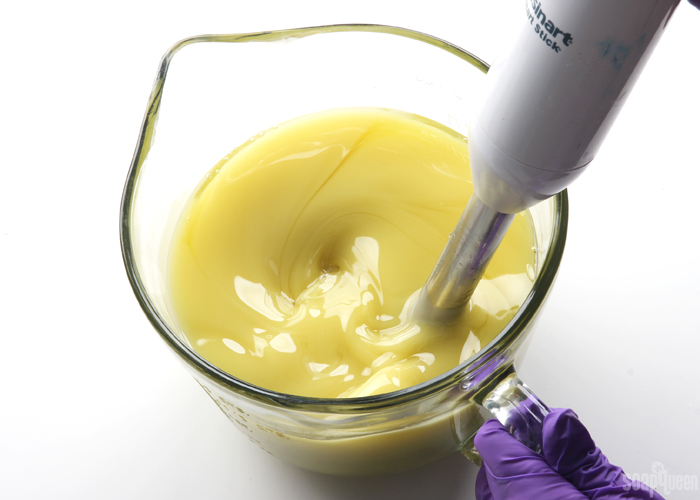 Fresh soap batter can still sting the skin. Wear your safety gear throughout the entire soaping process!
Fresh soap batter can still sting the skin. Wear your safety gear throughout the entire soaping process!
After 20 years of making cold process soap, I can firmly say that I have never had a serious lye burn. My worst lye experience was soap batter on a fresh cut. Wowza, that stung! But, after washing the cut in cool water for a few minutes, no serious harm was done.
My last tip for using lye correctly and safely for soap is to purchase your lye from a reputable source. Drain cleaners contain sodium hydroxide, but they are not suitable for soaping because they contain other ingredients. This may also be true for lye at hardware stores. Always check the ingredients thoroughly, and make sure the ingredients are sodium hydroxide only. Lye sold at Bramble Berry is 98% pure. The other 2% is an anti-caking agent that does not affect the soaping process.
Long story short? Working with lye for the first time is scary. A little bit of healthy fear is good because it can cause bodily harm. But, if you want to try cold process soap, don’t let fear hold you back! On the flip side, lye is a serious chemical that should be taken seriously. To learn more about using sodium hydroxide safely, check out my Lye Safety Guide. Then, watch the Soap Queen TV video above. It’s an oldie, but all the lye safety information still applies.





What about cleanup? When I’m finished making the soap should I spray everything and all equipment with white distilled vinegar and then wash thoroughly with hot water or just use dawn soap and hot water? I’m wanting to make the move to cold process soap but want to be completely prepared to handle the process and cleanup.
We normally just scrape off the excess soap and then use a good grease-cutting dish soap and hot water for clean-up. Our Soapy Session Clean Up Guide blog post may help you feel more comfortable with that part.
hi,
i am jus a beginner and have never made a soap in my life buthav jus started to pick it up as my new hobby and hav started studyng abut it and came across your site..ihave a few question wic i wud lik to be answered if possible.
1) how to calculate the ingredients while making lye.
how much of water and how much of the sodium hydroxide?
2)how to calculate required oils and lye and everything else
You can use our Lye Calculator to find out how much water and lye you need. All you have to do is plug in the oils and it will find it for you: https://www.brambleberry.com/Pages/Lye-Calculator.aspx
How much oil you use depends on the size of your mold. Do you know how much weight it holds?
-Kelsey with Bramble Berry
I would love to try CP soap, but I am terrified of having lye in my house because of my kids. I have a two year old and 6 month old. Of course I would do everything possible to keep it away and out of their reach, but 2 year olds are notorious for finding a way to get into everything that they shouldn’t. I know it’s unlikely, but I can’t shake the fear. Any suggestions apart from purchasing an expensive safe to keep it locked in?
We definitely recommend keeping your lye out of reach of children, whether that is a locked cabinet or somewhere they can’t reach. You also want them out of the room when you’re making soap so you don’t have any distractions. You may check teachsoap.com/forum. Many of the soapers there have kids, and they may have tips for soaping when they’re in the house.
-Kelsey with Bramble Berry
I’ve been thinking of trying CP, I’ve been failing at my MP lately. My husband thinks it’s my Essentail oils. I don’t want to waste more $ on MP bases, only to burn them. I’m thinking of a infrared gun but feel like I should be able to use a microwave. Do you have any suggestions?
I can definitely offer some suggestions! When melt and pour burns, it can harden quickly, form a skin or discolor. An infrared thermometer to check the temperatures helps. It also helps to melt the soap on short bursts – as little as 5 seconds for smaller batches. Adjusting the microwave setting to low can prevent burning as well. 🙂
Get more tips here: https://www.soapqueen.com/bath-and-body-tutorials/tips-and-tricks/how-to-avoid-burnt-melt-pour/
-Kelsey with Bramble Berry
Well, I was working at the lab several years ago, and my hands and clothes contacted all kinds of corrosive chemicals – sulfuric acid, nitric acid, various bases, etc.. I must say that alkali burns usually way severe than acid burns – because acid cause coagulation of proteins: the layer of affected protein creates a barrier, protecting against further damage. Alkali causes hydrolysis, so, it just liquefies any organic matter that comes in contact. Sorry, that might sound unpleasant.
So yeah, the protection is very important! I am kinda paranoid, so I always wear an apron or a lab coat – something that I can quickly take off. And, as has been said, you may want to keep some neutralizing agent nearby – vinegar, citric acid solution (1%). We used acetic acid solution in the lab.
Absolutely, we encourage people to wear whatever makes them feel safe when working with lye! A lab coat is a great idea. Some soapers also like to wear masks to protect them from lye fumes. Extra safety gear is never a bad idea. 🙂
-Kelsey with Bramble Berry
Guess I’m the rebel that started off on the opposite end of the pH spectrum. My dad is a tiler and concreter, so I was raised around concrete and acid. Those days it was okay to have a kiddy offsider helping out the old man for pocket money. That said, I only ever got acid burned once, in about fifteen years of working for pocket money. You don’t need a particularly strong solution, so it wasn’t like handling stuff that dissolves bodies etc. Probably the only reason it actually burned me was the length of exposure time, I hadn’t noticed the splash on my clothes until that night when I showered. Moving to lye was just starting again at the opposite end of the pH spectrum.
That said, the concentrate of the solution between drain cleaner and what we use for soapmaking is dramatically different. My NaOH bottle says “55g to 1L water for cleaning drains”. That ratio is 5.5:100. My ratio for soap fluctuates between 1:1.5 and 1:2.5. Big difference in strength of solution. And the soap concentration thus has a significant difference in the level of danger handling it compared to my drain cleaner. I addressed this as an advantage in a set of of university papers I wrote on the handmade manufacturing business. This particular point discussed leveraging the danger and tightly controlled regulations to your advantage, making your handmade manufacturing business highly profitable. It was loads of fun and I got to introduce the industry and present my works to some VIPs at my uni.
And if you’re really worried about lye splashes, Diphoterine is your bestest friend ever, forget vinegar and water. a bit $$$ but I don’t put a price on my vision.
Hi Tash!
My dad worked in construction for many years, and did a lot of work around the house as well. I have lots of fond memories of helping him, although he never let me do anything too dangerous. But I think it’s great for kids to learn the importance of safety at an early age :). You’re right, drain cleaner and lye used for soaping are quite different. That paper sounds so interesting!
-Amanda with Bramble Berry
I always keep distilled vinegar on hand to neutralize any accidental spatters on the skin, along with washing. I also clean my kitchen surfaces with dish towel that has vinegar on it just in case I might have left any caustic soap batter or drips for my kiddos to accidentally come in contact with. This might be overboard! But it helps me to feel confident that it is clean and safe.
Absolutely, take whatever steps necessary to make yourself feel safe! That is a a good policy when working with a caustic chemical. 🙂
-Kelsey with Bramble Berry
I made my first CP soap at age 47 so I was a little older when I started and it has become a great hobby to replace drinking too much. Perhaps it’s because I’m older that my attitude is “don’t fear lye, BUT DO respect it.” In other words, I did research, watched videos, learned safety procedures, etc and I always follow them so I don’t fear lye. However, I absolutely do respect the potential danger it possesses. I only had one incident that actually was not with lye. I finished cooking a hot process batch (fully cooked) and thought it was safe to mold the soap without goggles because it is hot process and it is fully cooked. A piece of hot soap flew into my eye: O U C H times 1000! Be safe, research, respect lye and you should be fine. Thanks to all the folks at Brambleberry for all the articles and training! This has been a great hobby to replace a bad habit and my soaps are a weekly part of a community project.
Ouch, that sounds painful! Glad you’re OK. I totally agree – lye should be respected but not feared. Proper safety gear is a must. 🙂
-Kelsey with Bramble Berry
Great info! I was actually the opposite, I started with cold process and later started doing M&P. I too was always afraid of lye, not knowing anything about it really except that it was “dangerous”. Before I started making soap I did a lot of reading and bought Anne Marie’s DVD which I watched a million times – this was before I knew anything about Bramble Berry and Soap Queen/Soap Queen TV/You Tube. I was pleasantly surprised to know Bramble Berry was just up in Bellingham (I’m in Portland). I bought the beginner’s CP kit from Bramble Berry and having done research and watching the process on the video, I wasn’t worried at all and my first batch of soap turned out just fine. I even did OK with a stick blender and recognizing trace. So thank you to Anne Marie for being a pioneer and making things so easy and wonderful for the rest of us!!
You’re welcome Michael! Once you make your first batch of cold process soap it’s hard to stop. 😉
-Kelsey with Bramble Berry